|
CLICK
HERE to download FREE Options Analyzer
Options as an alternative investment
Learn more advanced strategies than buy and hold..
Make money in down markets. Profit whether the stock goes
up or down. Try Options as an alternative investment.
Options give you a virtually unlimited number of profit
opportunities for ANY direction (up, down, choppy, or still) you think the stock is headed.
You can limit both your profits and losses. You can control
much larger quantities of stock for the same cost of buying the stock.
Option Basics
Perhaps you have invested in a 401k.
Maybe you have bought or sold stocks, bonds, or mutual funds.
Options can be the next step in your short or long term investment
strategies.
Different forms of options are used everyday. Why do you have
insurance on your
house and car? It's to protect your property from an unlikely
catastrophe for
a small amount known as a premium. In the same way some investors
buy options on stocks and indexes as insurance protection against
their holdings.
The biggest advantage of options is their flexiblity. They can be
as conservative or
speculative as your investment style needs to be. Here are some
examples of strategies you can do with options:
Protect
your existing stock or mutual funds from big declines. (buy puts)
Profit
fully from a stock increase for a fraction of the cost. (buy calls)
Profit
generously from a stock increase for a smaller fraction of the cost.
(bull spread)
Take
in a monthly income from a stock you own. (covered calls)
Receive
a payment for the opportunity to buy a stock at a discounted price.
(put writing)
Profit
from a market move up OR down. (straddles)
Benefit
if the market stays still. (short straddles)
Buying Calls and Puts
The most fundamental options strategy is to buy call or buy puts.
First select a stock you are interested and go to an options chain
quote service such as:
The Chicago Board Options Exchange CBOE:
http://quote.cboe.com/QuoteTable.asp
Dreyfus Brokerage:
http://www.edreyfus.com
Type in the symbol and you will get a list of available options.
Here is an options chain for Microsoft on 11/7/01:
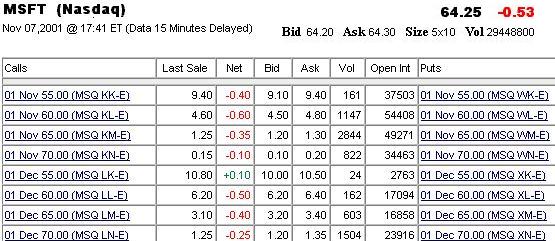
Select
an option you would like to purchase.
The Calls are on the left and Puts are on the right.
You will see the expiration date and exercise price for each option.
The premium quotes are listed under: last, bid, and ask.
In order to calculate the cost of the option, multiply the (premium)
x (number of contracts) x (100 shares per contract) Myths about
options
Myth 1:
"Options are very risky.. They are gambling"
While this can be certainly true for just buying options, option writing (or selling)
gives the investor many very conservative and high probability options strategies.
Options can even be used as insurance against existing stock positions.
Myth 2:
"Options are too complicated"
Understanding the basic option concept can be difficult at first. Read the intro
section for a very easy way to understand options.
Myth 3:
"Options are for rich people"
Buying options requires very little investment capital (under $1,000). Writing options account requirements
have dropped down to under $10,000 for many brokerages.
Myth 4:
"Options are rare and not easy to trade"
Options trading has exploded over the past 5 years. Now, options are available on over 2700 stocks.
All major online brokers now offer options trades as low as $1 a contract.
Myth 5:
"Most options expire worthless"
This can be true if there are more "out of the money" options than "in the money" and you are always the BUYER
of the option. If you become the SELLER of the options than you can take advantage of this. Options are "rain checks"
An option is a right to buy or sell an asset for a specified price and time.
Let's say you want to buy a TV on sale at Wal-Mart. You drive there only
to find out that it's "sold out". So you go to the clerk and ask for a
"rain check". This "rain check" is a guarantee that you will get the TV
for the sale price when they are back in stock. There may be an expiration
date on the "rain check" for 1 month from the out of stock date.
This rain check qualifies as an Call option. You have the right to purchase
the TV for the sale price up to 1 month regardless of how much the
TV goes up or down in price during that period. You are the buying this
call option and Wal Mart is the seller. The only difference of this
rain check versus a real option is that there is NO value on this option and
it is probably non-transferable.
Now, let's use this same concept for a stock. For instance, you want to
buy Microsoft stock and it is trading at $50 a share. Instead of buying the
stock, you decide to purchase a "right to buy the stock at 50" which will
expire on 1/15/01. You would be willing to pay $3 for this right to buy Microsoft
before 1/15/01 at $50. On the other side of this deal, there is someone
who is willing to sell you this right for you to buy Microsoft from him for 50.
He wants $3 for granting you this contract.
Comparison table: Stock option VS Rain check for TV
|
Option components: |
|
Stock |
|
Rain check for TV |
|
Expiration Date |
|
1/15/2000 |
|
1/15/2000 |
|
Strike (exercise) price |
|
50 |
|
500 |
|
Call (buy) or Put (sell) |
|
call |
|
call |
|
Option price |
|
3 |
|
NO VALUE (non transferrable) |
Buying a Call option and the power of leverage
In the previous example, we are buying a Microsoft 50 Call Option for $3.
This would be the right (but not the obligation) to buy Microsoft for $50 on or
before the expiration date. On expiration, if Microsoft is below $50 the
option expires worthless and you would lose your $3.
If it is anywhere above $50, you would profit dollar per dollar less your $3 cost.
A profit loss table for 1 call option contract (100 shares, total cost: $300) would look as follows:
| stk
price |
20 |
30 |
40 |
50 |
60 |
70 |
80 |
| p/l at exp |
-300 |
-300 |
-300 |
-300 |
700 |
1700 |
2700 |
| p/l% at exp |
-100% |
-100% |
-100% |
-100% |
233% |
567% |
900% |
The same $300 investment in buying MSFT would have got you only 6
shares:
| stk
price |
20 |
30 |
40 |
50 |
60 |
70 |
80 |
| p/l at exp |
-180 |
-120 |
-60 |
0 |
60 |
120 |
180 |
| p/l% at exp |
-60% |
-40% |
-20% |
0% |
20% |
40% |
60% |
As you can see, the power in buying options involves controlling
substantially more shares for the same cost. You also limit your
maximum risk to the lower cost of the option. The only
downside to buying options is that your probability is high that the
stock will stay the same resulting in you losing some or all of your
option value. 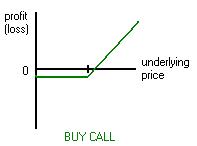 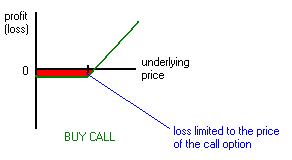
CLICK
HERE to analyze a Call Option
(requires Microsoft Excel to run)
(1) click 'Open' at save file prompt
(2) click 'Cancel' at username password prompt (if prompted)
(3) click 'Enable Macros' to run program
Buying Put Options
Buying put options are the same strategy as buying calls, only
betting the stock will go down instead of up. So the you could buy a
50 Put Option for $3. This would be the right to SELL Microsoft for
$50 before the expiration date. On expiration, if Microsoft is above
$50, the option expires worthless and you would lose your $3.
If it is anywhere below $50, you would profit dollar per dollar less
your $3 cost.
A profit loss table for 1 put option contract (100 shares, total
cost: $300) would look as follows:
| stk
price |
20 |
30 |
40 |
50 |
60 |
70 |
80 |
| p/l at exp |
2700 |
1700 |
700 |
-300 |
-300 |
-300 |
-300 |
| p/l% at exp |
900% |
567% |
233% |
-100% |
-100% |
-100% |
-100% |
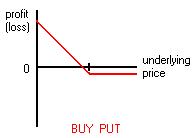
CLICK
HERE to analyze a Put Option
(requires Microsoft Excel to run)
(1) click 'Open' at save file prompt
(2) click 'Cancel' at username password prompt
(3) click 'Enable Macros' to run program
Writing options for high probability investing
Naked Puts
A "naked put" is simply selling or writing a put option
instead of buying it.
Here, you would be selling a 50 put for $3. You would give someone
else the
right to sell you the stock for $50 on or before expiration for a $3
credit.
| stk
price |
20 |
30 |
40 |
50 |
60 |
70 |
80 |
| p/l at exp |
-2700 |
-1700 |
-700 |
300 |
300 |
300 |
300 |
| p/l% at exp |
-900% |
-567% |
-233% |
100% |
100% |
100% |
100% |
Here your loss would be almost unlimited and your profit would be
limited to $300.
The probability would be high that the stock would stay the same or
go up giving you the $300 profit.
Covered Calls
A "covered call" has the same exact profit and loss
table as a naked put.
Here you would buy 100 shares of a $50 stock and sell (write) a 50
call for $3.
Basically, selling the 50 call would give someone the the right to
buy the stock
from you for $50 on or before expiration. In return for granting
this, you will
receive $3. Should the stock close above $50 at expiration, you
would end up
selling your stock to that person for $50 and profiting $300. If the
stock is
below $50, you would still own it and keep the $300.
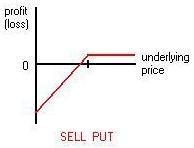
CLICK
HERE to analyze a Covered Call
(requires Microsoft Excel to run)
(1) click 'Open' at save file prompt
(2) click 'Cancel' at username password prompt (if prompted)
(3) click 'Enable Macros' to run program
Buying a put as insurance for an existing stock position
If you own an existing stock and are worried that there may be
huge correction
in the short term, you can buy a put to insure the stock against
such a catastrophe.
For example, you own 100 shares of a stock with a current price of
$50.
You buy a 40 put for $1 which expires in one month. Should the stock
drop toward $40 on or before expiration, your profits from the put
could offset the losses on the stock.
| stk
price |
20 |
30 |
40 |
50 |
60 |
70 |
80 |
| stock pl |
-3000 |
-2000 |
-1000 |
0 |
1000 |
2000 |
3000 |
| put option pl |
2900 |
1900 |
900 |
-100 |
-100 |
-100 |
-100 |
| NET pl |
-100 |
-100 |
-100 |
-100 |
900 |
1900 |
2900 |
The put will limit your total losses to only $100 (cost of the
put) reduce your gains by the same amount.
Bull Spread - a conservative option play
A more conservative approach to just buying a call would be the
bull spread.
This involves buying one call and selling another call further out.
For example, a stock is trading at $50 and you buy the 50 call for $3
and sell the 60 call for $1.
This would result in a spread position where you max loss and profit
are limited. The max
profit would be $800 and the max loss would be $200 (net cost).
The PL at expiration table would look as follows:
| stk
price |
20 |
30 |
40 |
50 |
60 |
70 |
80 |
| buy
50 call@3 |
-300 |
-300 |
-300 |
-300 |
700 |
1700 |
2700 |
| sell
60 call@1 |
100 |
100 |
100 |
100 |
100 |
-900 |
-1900 |
| net
pl |
-200 |
-200 |
-200 |
-200 |
800 |
800 |
800 |
This position in comparision to just buying the call, would give
you a lower maximum risk and limit the max profit to $800.
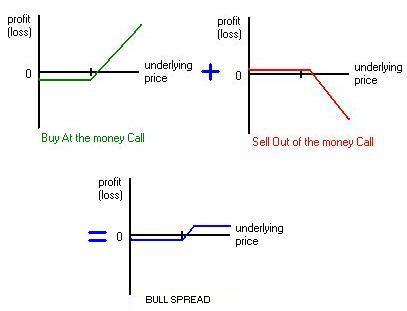
CLICK
HERE to analyze a BULL
SPREAD
(requires Microsoft Excel to run)
(1) click 'Open' at save file prompt
(2) click 'Cancel' at username password prompt (if prompted)
(3) click 'Enable Macros' to run program
Straddle - Making money up or down
A straddle option spread allows you to make money whether the stock
moves up OR down. It is simply combining a buy put and buy call
option. The Straddle will only lose if the stock stays the same.
The PL at expiration table for a STRADDLE would look as follows:
| stk
price |
20 |
30 |
40 |
50 |
60 |
70 |
80 |
| buy 50 call@3 |
-300 |
-300 |
-300 |
-300 |
700 |
1700 |
2700 |
| buy 50 put@3 |
2700 |
1700 |
700 |
-300 |
-300 |
-300 |
-300 |
| net pl |
2400 |
1400 |
400 |
-600 |
400 |
1400 |
2400 |

Short Straddle - Making money if the Stock stays the same
A Short Straddle is the opposite of the straddle. It is combining a
SELL call and SELL put option.
The PL at expiration table for a SHORT STRADDLE would look as
follows:
| stk
price |
20 |
30 |
40 |
50 |
60 |
70 |
80 |
| sell 50 call@3 |
300 |
300 |
300 |
300 |
-700 |
-1700 |
-2700 |
| sell 50 put@3 |
-2700 |
-1700 |
-700 |
300 |
300 |
300 |
300 |
| net pl |
-2400 |
-1400 |
-400 |
600 |
-400 |
-1400 |
-2400 |
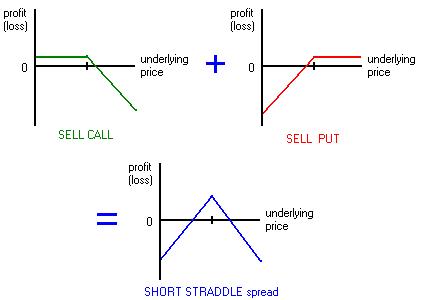
CLICK
HERE to analyze a STRADDLE
(requires Microsoft Excel to run)
(1) click 'Open' at save file prompt
(2) click 'Cancel' at username password prompt (if prompted)
(3) click 'Enable Macros' to run program
SUMMARY TABLE: Basic Option Strategies TABLE
| STRATEGY |
Options |
|
DIRECTION |
MAX
PROFIT |
MAX
RISK |
| |
Components* |
|
|
|
|
|
|
| Buy Call |
bc |
|
very
bullish |
unlim |
|
cost of
option |
| Buy Put |
bp |
|
very
bearish |
unlim |
|
cost of
option |
| Sell Call |
sc |
|
moderate
bearish |
cost of
option |
unlim |
|
| Sell Put |
sp |
|
moderate
bullish |
cost of
option |
unlim |
|
| Covered Calls |
bu+sc |
|
moderate
bullish |
cost of
option |
unlim |
|
| Bull Spread |
bac+soc |
|
bullish |
|
strike
spread |
cost of
options |
| Bear Spread |
bap+sop |
|
bearish |
|
strike
spread |
cost of
options |
| Straddle |
bc+bp |
|
volatile |
|
unlim |
|
cost of
options |
| Short Straddle |
sc+bc |
|
neutral |
|
cost of
options |
unlim |
|
| *Option Component Abbreviation table |
|
|
| |
|
|
|
|
|
| buy
at the money call (bac) |
sell at
the money call (sac) |
| buy
at the money put (bap) |
sell at
the money put (sap) |
| |
|
|
|
|
|
| buy
out of the money call (boc) |
sell out
of the money call (soc) |
| buy
out of the money put (bop) |
sell out
of the money put (sop) |
| |
|
|
|
|
|
| buy
in the money call (bic) |
sell in
the money call (sic) |
| buy
in the money put (bip) |
sell in
the money put (sip) |
CLICK
HERE to analyze a CUSTOM
POSITION
(requires Microsoft Excel to run)
(1) click 'Open' at save file prompt
(2) click 'Cancel' at username password prompt
(if prompted)
(3) click 'Enable Macros' to run program
CLICK
HERE to download Optionstar EZ (options analyzer)
(requires Microsoft Excel to run)
(1) click 'Save' at save file prompt
(2) click 'Cancel' at username password prompt
(if prompted)
(3) In Windows, Double click on OSEZ.exe file
(4) Click 'Extract' in the directory you
want the file to go to.
(5) Double click on the file or open it from Excel.
| 







